Sundrop Crystal Gift Shop

~ Fun Food‑Candle Pictures! ~
Fun Food Candles! Enjoy these great pictures of Fabulous Fun Fake Food!
Bunches of grapes, bottles of wine, a beautiful Bosc pear, and an incredible Mixed Fruit Tart! These are not food, they are Candles! Yes, Incredible Candle Artwork! Unfortunately, they are Discontinued and not available for purchase. We are very sorry. But we love the pictures so much that we want you to be able to see them! Below the photos you can find interesting Candle Information! Have a Look! Enjoy! |










|
~ We Wish You A Happy Day! ~ |
 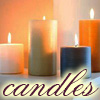 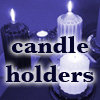 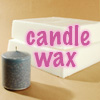 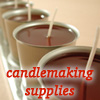 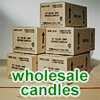
~ All About Candles! ~
How does a candle burn? An interesting thing about a candle is that it is a very good example of the four states of matter. The four states of matter are Solid, Liquid, Gas, and Plasma. Wax, the fuel source of a candle goes through all four of these states of matter.
Let’s see what happens when we light a candle. We need a catalyst to start the whole thing going, so we touch a flame to the end of the wick. At first the wick itself starts to burn. The flame creeps down the sides of the wick and usually diminishes until it touches the wax. This is when the mechanism starts to work. The heat from the flame melts the wax surrounding the base of the wick directly beneath it. By the principle of capillary action the melted wax is drawn into the wick providing fuel for the flame which bursts to life.
The candle continues to burn through an ongoing cycle. Wax in a solid state of matter is melted by the heat of the flame and converts it to a liquid state of matter. The liquid wax is drawn up to the tip of the wick inside the flame. At this stage the liquid wax is heated even more and it vaporizes changing into a gaseous state of matter. The gaseous wax enters the combustion area of the flame and is converted to energy. The energy conversion gives off heat, which melts more of the solid wax. The cycle repeats itself until the wick no longer functions due to consumption or lack of fuel for the flame. |
 
What are votive candles? The word "Votive" comes from the Latin "Votivus", from "Votum" meaning "Vow". A vow is a promise usually made for spiritual or religious purposes. As far back as the middle ages candles were lit to symbolize the taking of a vow or to acknowledge devotion. Often votive candles are lit and devoted to the memory of a loved one who has passed away or as an offering to favor the answering of a prayer.
Votive candles were intended to burn for long periods of time. The best votive candles for this purpose are made from a wax that melts at a low temperature. Wax that melts at a lower temperature liquefies easier and is more readily available to be drawn into the wick and into the flame for combustion. This is why all quality votive candles must be burned in a proper heat resistant container.
Many modern votive candles which are available to common consumers are not true "Votive" candles. Most are made from a wax with a higher melting temperature and are only called votive candles because they resemble traditional votive candles. The majority of consumer votive candles come in a vast variety of colors and fragrances. Scented votive candles are among the top selling candles, Ivory / Vanilla is frequently the most popular color /fragrance, followed closely by Red / Spice.
The largest consumers of uncolored / unscented votive candles are churches and restaurants. Church use of votive candles is traditionally for acts of devotion, whereas restaurants use votive candles for romantic light sources at dinner tables or as small heating elements at serving tables.
The most common wax used for traditional votive candles is paraffin wax. A special grade of paraffin wax is used for votive candles which has a melting temperature around 125° F. and has a higher oil content than most waxes. |

What is a candle? A candle is a device for providing light or dispersing fragrance. The body of a candle is comprised of a solid fuel source, usually paraffin candle wax. Other natural candle waxes are also available, such as palm wax, beeswax, and new soy wax. A wick runs through the center of the body of the candle from the bottom, extending out of the top. The wick, which acts as a fuel pump when the candle is burning, is generally made
of cotton fibers that have been braided together.
Soot stained stone dishes found in ancient caves in France show that stone-age man used a crude candle/lamp to light the cave walls as he painted upon them. The saucer shaped stone appears to have held a piece of animal fat that could be set afire to give off light. Ancient Egyptians were known to drip beeswax or tallow onto rush stems. They would set flame to the tip of these "Rush Lights" to provide them with light.
Today, we do not rely so much on candles for lighting our homes, except in the event of a power outage. Candles are now used for decorative or religious purposes, to create a mood with their hypnotic glow, their soothing fragrances please our sense of smell, and they often represent symbols of our personal faiths.
A candle is the light, the body, the soul of our modern imaginations.

Where does wax come from? There are two main waxes used in candlemaking, Paraffin Wax and Beeswax. More recently, Soy wax is also used.
PARAFFIN WAX Paraffin wax, which is classified as a natural wax, is the most common wax used in candlemaking, and can be said to ultimately come from plant life.
In order to protect themselves from adverse weather conditions plants produce a layer of wax on their leaves and stems. Material from dead plants 100-700 million years ago accumulated in large quantities and eventually became buried beneath the surface of the earth. After a long period of time, forces of heat and pressure turned the slowly decaying plant material into crude oil, otherwise known as petroleum. Because of the nature of waxes, being inert and water repellent, they were unaffected by the decomposition of the plant
material and remained intact, suspended within the crude oil.
Petroleum companies "harvest" the crude oil and process it. They refine the oil, separating the different properties into Gasoline, Kerosene, Lubrication Oil, and many other products. In many cases, the wax in the petroleum is considered undesirable and is refined out. The refinery will process the wax into a clean, clear liquid, or as a solid milky white block, and make it available to companies who may have a use for it.
The refined wax is called paraffin, which comes from the Latin "parum = few or without" and "affinis = connection or attraction (affinity)". Basically there are few substances that will chemically react with or bind to this type of wax.
BEESWAX A less common but more highly renowned wax for candlemaking is beeswax. Classified as a natural wax, it is produced by the honeybee for use in the manufacture of honeycombs.
Beeswax is actually a refinement of honey. A female worker bee eats honey, and her body converts the sugar in the honey into wax. The wax is expelled from the bee's body in the form of scales beneath her abdomen. The bee will remove a wax scale and chew it up, mixing it with saliva, to soften it and make it pliable enough to work with, then attach it to the comb which is being constructed. Usually another bee will take the piece of wax which has just been attached to the comb, chew it some more, adding more saliva to it, and deposit it on another section of the comb. The combs are built up, honey is deposited inside, and then the combs are capped with more wax. Since several worker bees construct the comb at the same time, and the hive is constantly active with other bees flying around and walking on the combs, depositing foreign matter onto the combs, the composition of the wax becomes very complex.
As is the case with paraffin, collecting beeswax is also the byproduct of a process. The beekeepers’ main interest is in the collection of honey. The capping wax must be removed in order to extract the honey; they save the capping wax until they've collected enough to make it available to market.
Because beeswax is harvested in relatively small quantities it does not boast the same availability as paraffin and is therefore more expensive. It is used extensively in cosmetics and candlemaking. Candles made from 100% beeswax are generally held in high regard. When burning they glow beautifully and impart a very pleasant honey like aroma. |
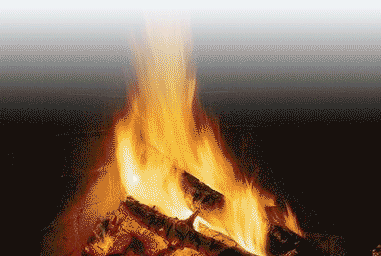
Indulge In The Fabulous Fireside Candle Collection
How does a candle wick work? A candle without a wick is just a hunk of wax. The wick is what a candle is all about. The earliest known candles were basically a wick-like material coated with tallow or beeswax, not even resembling a candle at all. In taper candles the wick is the structure which supports the first layers of wax that create the candle. In all candles it acts as a fuel pump, supplying liquefied wax up to the top where all of the action takes place. As a regulator, different size wicks allow different amounts of wax up into the combustion area providing different size flames. The wick is pretty much the most important element of a candle.
The word wick comes from Old English "weyke or wicke", Anglo Saxon "wecca", and Germanic "wieche or wicke". It is a name for a bundle of fibers that when braided or twisted together are used to draw oil or wax up into a flame to be burned in a lamp or candle.
A wick without wax around it is just a piece of string. Because the wick is fibrous and absorbent, melted wax adheres to it easily. Dipping a wick in and out of melted wax several times builds up layers of wax, sufficient enough to make a taper candle.
The wick works by a principle called capillary action. Cotton fibers are spun into threads, which are bundled and braided together. The spaces between the cotton fibers, the threads, and braids act as capillaries, which cause liquids to be drawn into them. If you place a drop of water in the center of a paper towel you will see that the drop is absorbed and the wet spot expands. Where the expansion occurs is where capillary action is taking place. The candle wicking absorbs wax the same way.
Candle wicking is available in several types. Probably the most popular is the Flat Braid, or Regular wick. Different sized wicks cause different sized flames simply because of the number of threads in the bundles. Each thread is considered a plait or ply, and a given number of ply are bundled together.
With Flat Braid wick, usually three bundles are braided together. It is braided so that all three bundles lie flat and is referred to by the number of plaits it contains. Example: (36 ply) - 3 bundles of 12 ply = 36 ply.
A 36 ply wick can draw a little bit more wax than a 30 ply wick, which gives the 36 ply wick a larger flame. In turn, the larger flame produces a slightly larger melt pool. The purpose for the flatness of this wick is to curl over to the side when it burns. This curling of the wick helps to prevent excess smoking. |

The Candle Flame The candle flame is the whole reason for the existence of the candle. The light given off by a candle allows us to see through the darkness. It creates romantic or nostalgic ambience for our living spaces. In our holy places the candle flame symbolizes our faith and devotion. We find calm or vigor from aromatic essences released by the heat of the flame in scented candles.
One might find oneself mesmerized by the intoxicating glow of the flame of a candle. A fascinating thing is a flame, dancing on the end of the wick of a candle, beckoning us to wonder and marvel at its existence. What is it? How does it give off its light?
Fire is a strange thing. It may be difficult to understand, but what we perceive as the flame of a candle is not truly fire at all, rather it is an effect of fire. Actual fire is virtually invisible to the naked eye. It is intense heat created by a chemical reaction. The light we see, as what we call a flame, is the luminescence of substances which are super heated but not burned, like a when a blacksmith works a horseshoe made of iron he has removed from hot coals. The iron glows bright orange but is not on fire. Elements passing through the flame of a candle glow brightly in the heat of an invisible fire.
A perfect example of the incandescence in an invisible fire is "limelight". You may have heard of limelight in reference to the 19th century stage or theater. At the time limelight was the brightest, most natural color of artificial light available. The light was produced by placing a block of lime (calcium oxide) within the combustion area of a hydrogen/oxygen jet flame. The flame from the combustion of hydrogen & oxygen gives off no light even though it is one of the highest temperature flames man can produce. Lime is not chemically affected by either hydrogen or oxygen, & has a very high melt point (2600 degrees). When a block of lime is placed within the flame it gives off light.
The reason that limelight is a perfect example to compare with a candle flame is that in limelight, calcium oxide is a non-combustible substance which gives off light when exposed to high temperatures. Its counterpart in the candle flame is carbon. When a substance is exposed to extreme heat its molecular structure may break apart. In a candle flame, hydrocarbons are broken apart. While the hydrogen atoms from the hydrocarbon combine with free oxygen to create water, the non-combustible carbon atoms are released. Driven upward on a column of hot air, the carbon atoms become incandescent as they pass through the invisible fire. This is what we perceive as the candle’s flame, the glow of floating carbon atoms. |

 |
~ Sundrop Crystal ~
Candles for Every Occasion!!
     
Beautiful Candles!

~ Beautiful Hanging Crystal Prisms ~
That Make
~ Fabulous Rainbows! ~

~ Sundrop Crystal ~
Fine Swarovski Crystal Prisms Since 1998



|
|
|
|
|